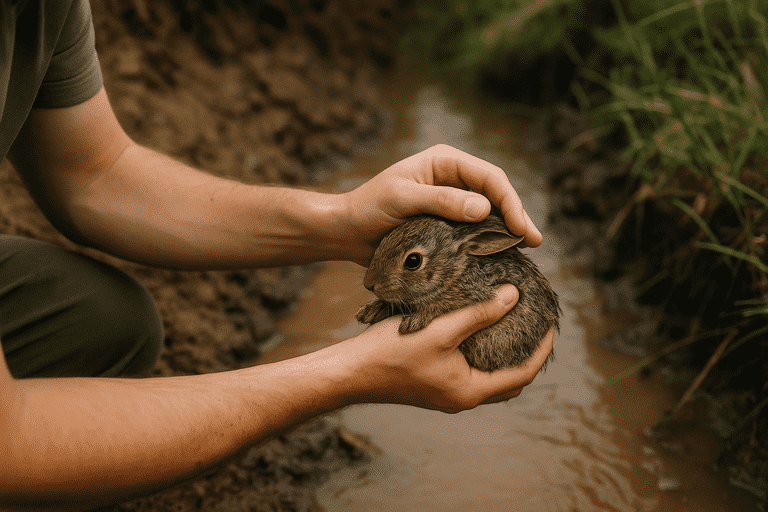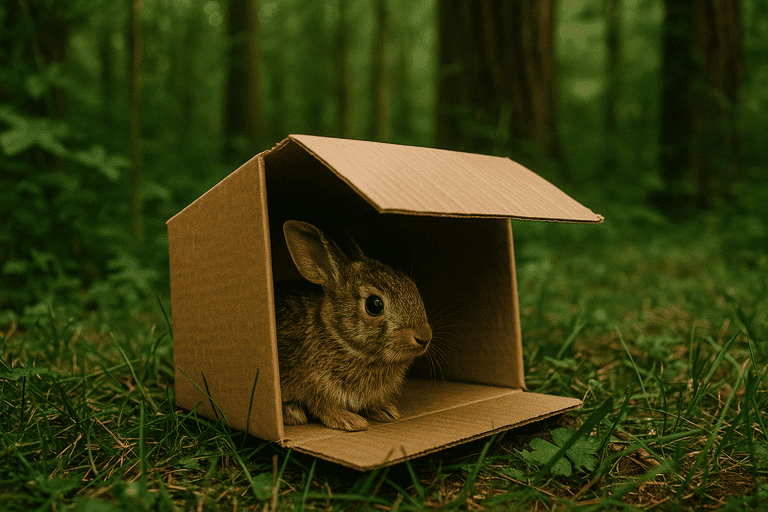Every spring and summer, people across the country come across small, vulnerable baby bunnies in their yards, parks, or near roads. While the first instinct is often to help, it’s important to understand the role that wild bunny rescue plays and when it’s truly necessary. For instance, mother rabbits typically leave their young alone for most of the day to avoid attracting predators. This behavior may appear as abandonment, but it is actually nature’s way of protecting the kits. Therefore, well-meaning humans often misinterpret this as a need for intervention.
Moreover, wild bunnies are extremely delicate. Their survival depends heavily on minimal stress and proper care. Improper handling or unnecessary rescue can lead to unintended harm. This is why knowledge and proper assessment are vital in every potential wild bunny rescue scenario. In addition, raising awareness in local communities can prevent unintentional interference that might endanger these animals.
Wild Bunny Rescue: When to Intervene
Determining whether a bunny needs rescuing is the first and most crucial step. In most cases, it’s best to observe from a distance. However, intervention becomes essential when a baby bunny is visibly injured, covered in ants or flies, cold to the touch, or if you have seen a dead mother nearby. In these cases, wild bunny rescue should be initiated immediately. For instance, a bunny lying motionless on its side or with labored breathing clearly needs medical attention.
Why Wild Canine Rescue Matters for Ecosystem Stability
In addition, domestic pets like dogs and cats can disturb or injure bunnies. If a bunny has been caught or chased by a pet, even if it appears fine, it should be examined by a wildlife expert. Therefore, if you suspect trauma or infection, it’s always safer to consult with a licensed rehabilitator. Wild bunnies are prey animals and can hide injuries well, so even minor wounds may escalate quickly.

How to Safely Handle a Wild Bunny Rescue
Handling wild bunnies improperly can lead to fatal consequences. When engaging in wild bunny rescue, always proceed with caution. For instance, never scoop the bunny up suddenly. Approach slowly and gently wrap it in a soft towel. Use gloves if possible, not because of human scent (as commonly believed), but to protect the bunny from unnecessary bacteria or contamination.
Furthermore, avoid overhandling. Stress is one of the leading causes of death in rescued bunnies. Keep the animal in a dark, quiet, and warm environment until professional help arrives. In addition, make sure to place the bunny in a box with air holes and avoid loud noises, pets, or frequent movement. Every moment counts in a wild animal’s recovery process.
Contacting the Right Wildlife Professionals
Once the bunny is secured, the next critical step is to get professional help. Many regions have local wildlife rehabilitators who are trained in proper animal care. You can find them through online directories, local shelters, or animal control services. During any wild bunny rescue, it’s essential to act swiftly. Licensed rehabilitators know how to feed, medicate, and release wild animals properly—things an average person isn’t equipped to do.
Wild Food as a Gateway to Self-Reliance and Natural Living
For instance, feeding a baby bunny cow’s milk or any formula not designed for rabbits can be deadly. Therefore, never attempt to feed the animal unless instructed by a professional. In addition, do not attempt to raise a wild bunny on your own—it is not only harmful but often illegal without the proper permits.

Preparing for Transport During a Wild Bunny Rescue
Transporting the bunny to a wildlife center must be done with care. Use a small cardboard box or pet carrier lined with soft material like a towel or old shirt. Make sure it is ventilated but secure, as bunnies may panic and try to escape. In a wild bunny rescue, transportation often becomes the most stressful part for the animal, so keeping the journey short and calm is vital.
However, never place the bunny in direct sunlight or a cold area during transport. Keep the box on your lap or in a stable, quiet place in the vehicle. Avoid loud music, talking, or any form of stimulation. In addition, do not attempt to look at or touch the bunny during the drive unless absolutely necessary. Your calmness could mean the difference between life and death for the rescued animal.
Why Domestic Care Is Not a Long-Term Solution
Many people feel compelled to care for a wild bunny themselves. While the intention is good, the execution is often harmful. Wild rabbits are not domestic pets. For instance, their diet includes a variety of native grasses and herbs that a typical household can’t provide. In addition, baby bunnies require a specific feeding schedule, temperature regulation, and grooming behaviors that are hard to replicate.
Therefore, after a wild bunny rescue, it’s critical to hand the animal over to trained professionals. Not only do they have the tools and experience to care for the animal properly, but they also know when and how to reintroduce it back into the wild. Releasing a bunny too early, or in the wrong area, can result in immediate predation or starvation.
Common Myths About Wild Bunny Rescue
A lot of misinformation surrounds wildlife care. One common myth is that touching a bunny causes the mother to reject it. However, rabbits do not rely heavily on scent like other animals. For instance, if you’ve touched a bunny but returned it to the nest without disturbing the surroundings, the mother will almost always return.
Animal Shelter in Wildomar: Community Benefits
Another myth is that every bunny you see alone is in danger. In fact, rabbits intentionally stay away from the nest to avoid attracting predators. They typically nurse their young just twice a day. Therefore, seeing a baby bunny alone does not necessarily mean it needs a wild bunny rescue. It’s always best to monitor the situation from a distance before deciding to intervene.

Final Thoughts on Responsible Wild Bunny Rescue
Helping wildlife can be an incredibly rewarding experience, especially when done correctly. The key to a successful wild bunny rescue lies in knowledge, patience, and responsible action. For instance, educating others about when and how to rescue can prevent thousands of unnecessary deaths each year.
In addition, supporting local wildlife centers through donations or volunteer work helps ensure more animals get the care they need. Whether you’re directly involved in a rescue or simply spreading awareness, your actions contribute to a healthier ecosystem. Therefore, always approach with compassion and caution—wild animals deserve both our help and our respect.
Additional Tips for Bunny-Friendly Backyards
While not directly related to hands-on rescues, creating a safe outdoor environment can prevent many wild bunny injuries. For instance, check your lawn carefully before mowing, especially during the breeding season. Many nests are hidden in plain sight in short grass. In addition, avoid using pesticides or harsh chemicals that can harm not only bunnies but other wildlife as well.
Fencing off garden areas can help keep bunnies out while protecting them from getting caught or trapped. Moreover, teaching children and pets to respect wildlife goes a long way in preventing future rescue situations. Proactive steps can minimize the need for future wild bunny rescue efforts.
How to Educate Others About Wild Bunny Rescue
Community education is one of the most powerful tools in wildlife conservation. Hosting local workshops, sharing reliable information on social media, and connecting with schools can spread awareness. For instance, providing simple flyers or graphics that explain when to intervene and when to leave a bunny alone can make a significant difference.
In addition, collaborating with local vets, shelters, and rehabilitation centers can help ensure that the information being spread is accurate and helpful. The more people understand the realities of wild bunny rescue, the better equipped they’ll be to make the right decisions in the moment.

